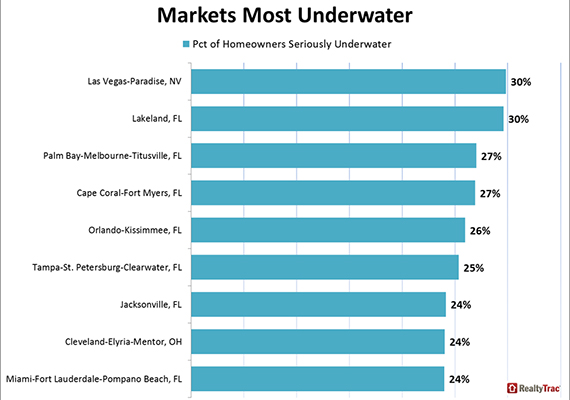Trending
Report: Miami ranks high in seriously underwater properties

Twenty-four percent of properties in Miami were “seriously underwater” at the end of 2014, according to a RealtyTrac report released Thursday.
Florida ranked first among states nationwide with 410,904, or 17 percent, of properties seriously underwater — where the combined loan amount secured by the property is at least 25 percent higher than the property’s estimated market value, according to RealtyTrac’s U.S. Home Equity & Underwater report for the fourth quarter of 2014. Florida is actually down from 1.6 million or 28 percent of properties seriously underwater at the end of the third quarter of 2014, and down further from 1.8 million, or 34 percent, at the end of the 2013.
Meanwhile, Miami tied for fourth place with Jacksonville, Cleveland and Detroit among cities with the most seriously underwater properties at the end of the year. Orlando was second on the list with 26 percent and Tampa took third place with 25 percent. Las Vegas topped the list of cities at 30 percent.
Miami also came in seventh among markets with the highest share of distressed properties that were seriously underwater, with 46 percent. Las Vegas again came in first with 60 percent; Tampa, 52 percent; Jacksonville, 50 percent; Orlando, 49 percent; Chicago, 48 percent; and Detroit, 47 percent.
Nationwide, 7.1 million properties were deemed seriously underwater at the end of 2014, representing 13 percent of all properties with a mortgage, according to the report. That’s down from a peak of 12.8 million, representing 29 percent of all homes with a mortgage in the second quarter of 2012.
“Median home prices nationwide bottomed out in March 2012 and since then have increased 35 percent, lifting 5.8 million homeowners out of seriously underwater territory,” said Daren Blomquist, vice president at RealtyTrac, in a statement. “While the remaining seriously underwater properties continue to be a millstone around the neck of some local markets, the growing number of equity rich homeowners should help counteract the downward pull of negative equity in many markets, empowering those housing markets — and by extension their local economies — to walk on water in 2015.”




